Analysis of Partnership Working in Health and Social Care: A Report
VerifiedAdded on 2020/02/03
|13
|4209
|45
Report
AI Summary
This report comprehensively examines the concept of partnership working within the health and social care sector, using the Mid Staffordshire National Health Foundation (NHS) Hospital Trust as a case study. It begins by defining the philosophy of partnership, emphasizing ethics, beliefs, and values that underpin effective collaboration among healthcare agencies. The report explores various partnership relationships, including strategic, inter-professional, and inter-agency collaborations. It then delves into different models of partnership working, such as unified, coalition, coordinated, and hybrid models, discussing their advantages and disadvantages. The report further analyzes current legislation and organizational practices, including the Health and Social Care Act 2012, the Equality Act 2010, and the Data Protection Act 1998; 2003, and how they influence partnership working. It also highlights how differences in working practices and policies can affect collaborative efforts, addressing issues like roles and responsibilities, differing objectives, and communication challenges. The report concludes by discussing the possible outcomes, potential barriers, and strategies to enhance partnership working, aiming to improve service user outcomes, professional practices, and organizational effectiveness in the health and social care sector.

Working in Partnership
Paraphrase This Document
Need a fresh take? Get an instant paraphrase of this document with our AI Paraphraser
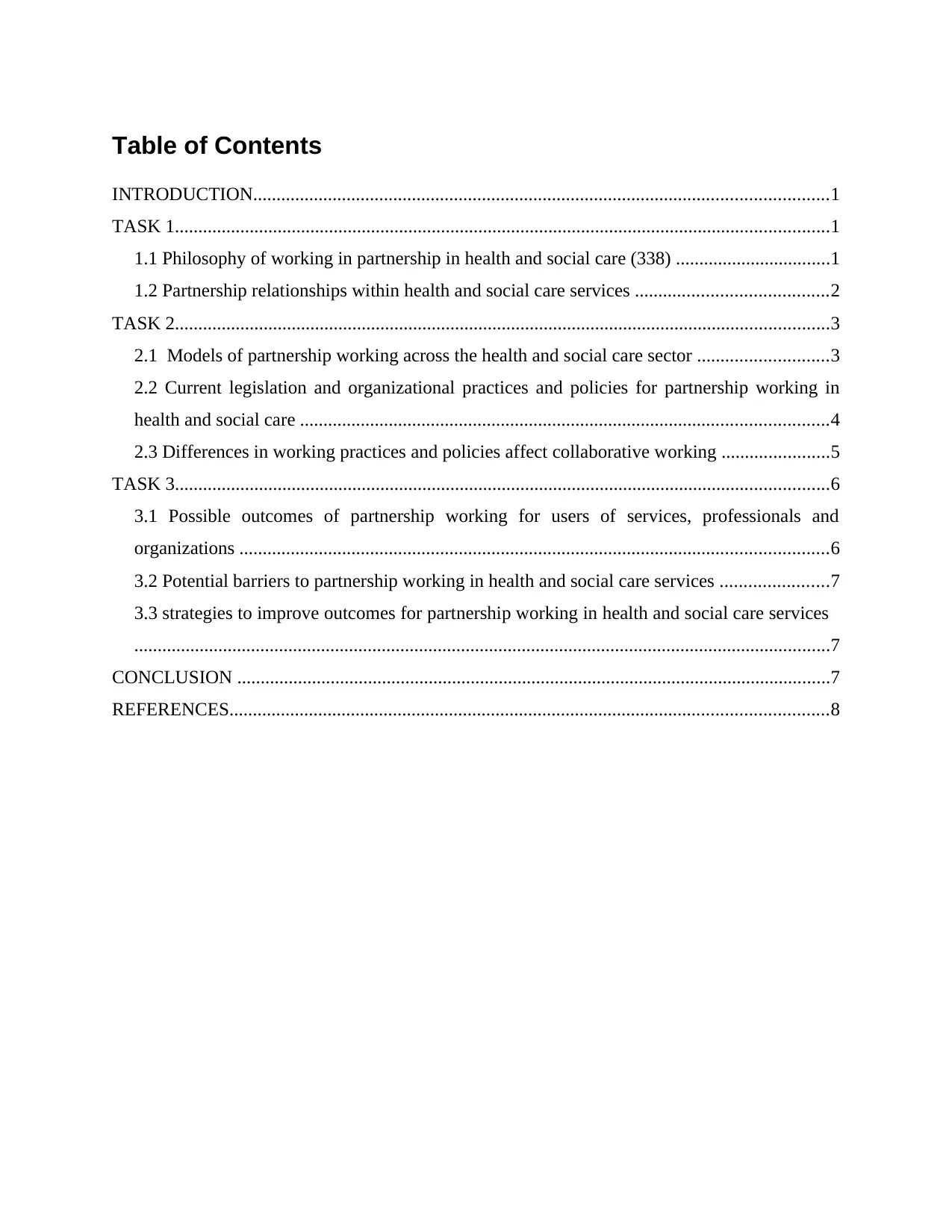
Table of Contents
INTRODUCTION...........................................................................................................................1
TASK 1............................................................................................................................................1
1.1 Philosophy of working in partnership in health and social care (338) .................................1
1.2 Partnership relationships within health and social care services .........................................2
TASK 2............................................................................................................................................3
2.1 Models of partnership working across the health and social care sector ............................3
2.2 Current legislation and organizational practices and policies for partnership working in
health and social care .................................................................................................................4
2.3 Differences in working practices and policies affect collaborative working .......................5
TASK 3............................................................................................................................................6
3.1 Possible outcomes of partnership working for users of services, professionals and
organizations ..............................................................................................................................6
3.2 Potential barriers to partnership working in health and social care services .......................7
3.3 strategies to improve outcomes for partnership working in health and social care services
.....................................................................................................................................................7
CONCLUSION ...............................................................................................................................7
REFERENCES................................................................................................................................8
INTRODUCTION...........................................................................................................................1
TASK 1............................................................................................................................................1
1.1 Philosophy of working in partnership in health and social care (338) .................................1
1.2 Partnership relationships within health and social care services .........................................2
TASK 2............................................................................................................................................3
2.1 Models of partnership working across the health and social care sector ............................3
2.2 Current legislation and organizational practices and policies for partnership working in
health and social care .................................................................................................................4
2.3 Differences in working practices and policies affect collaborative working .......................5
TASK 3............................................................................................................................................6
3.1 Possible outcomes of partnership working for users of services, professionals and
organizations ..............................................................................................................................6
3.2 Potential barriers to partnership working in health and social care services .......................7
3.3 strategies to improve outcomes for partnership working in health and social care services
.....................................................................................................................................................7
CONCLUSION ...............................................................................................................................7
REFERENCES................................................................................................................................8
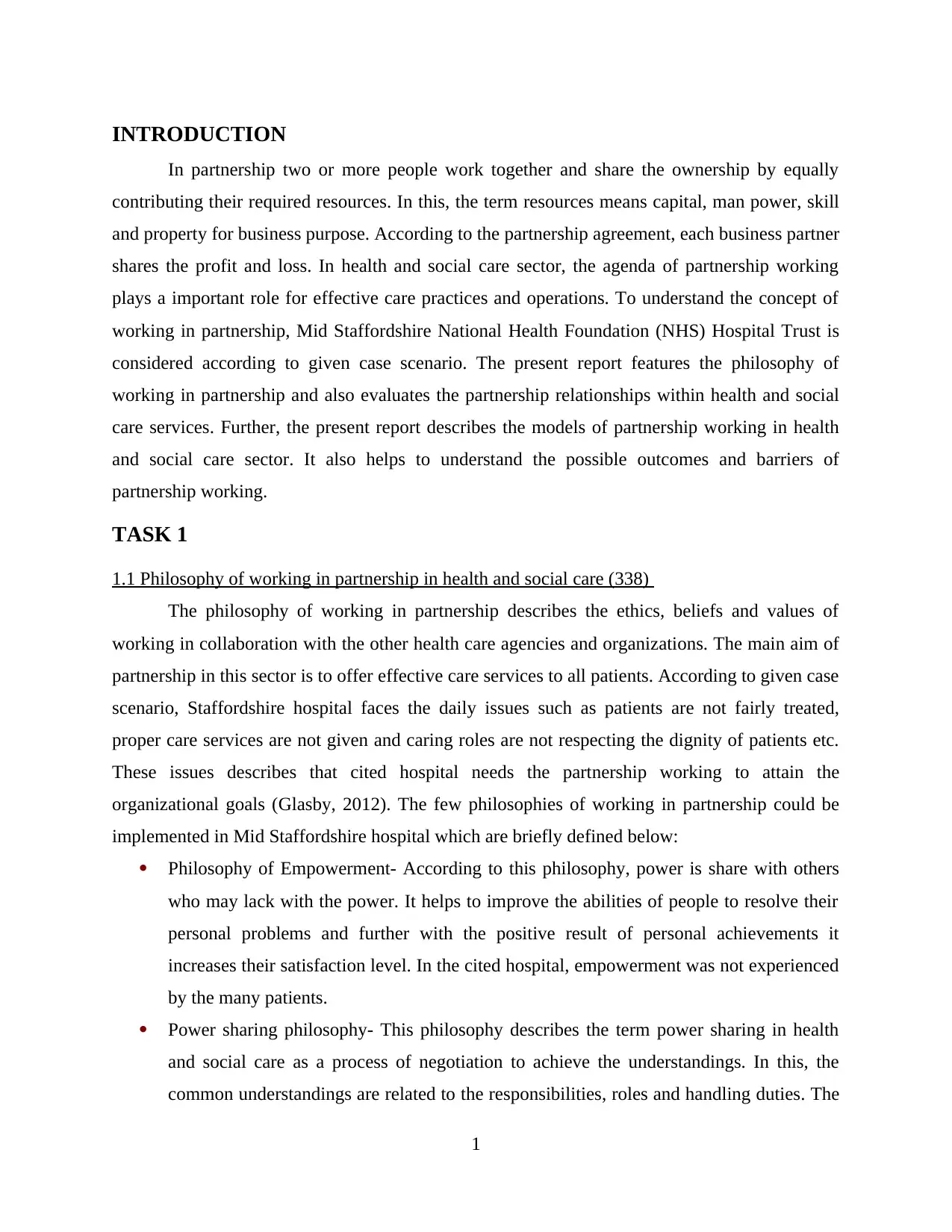
INTRODUCTION
In partnership two or more people work together and share the ownership by equally
contributing their required resources. In this, the term resources means capital, man power, skill
and property for business purpose. According to the partnership agreement, each business partner
shares the profit and loss. In health and social care sector, the agenda of partnership working
plays a important role for effective care practices and operations. To understand the concept of
working in partnership, Mid Staffordshire National Health Foundation (NHS) Hospital Trust is
considered according to given case scenario. The present report features the philosophy of
working in partnership and also evaluates the partnership relationships within health and social
care services. Further, the present report describes the models of partnership working in health
and social care sector. It also helps to understand the possible outcomes and barriers of
partnership working.
TASK 1
1.1 Philosophy of working in partnership in health and social care (338)
The philosophy of working in partnership describes the ethics, beliefs and values of
working in collaboration with the other health care agencies and organizations. The main aim of
partnership in this sector is to offer effective care services to all patients. According to given case
scenario, Staffordshire hospital faces the daily issues such as patients are not fairly treated,
proper care services are not given and caring roles are not respecting the dignity of patients etc.
These issues describes that cited hospital needs the partnership working to attain the
organizational goals (Glasby, 2012). The few philosophies of working in partnership could be
implemented in Mid Staffordshire hospital which are briefly defined below:
Philosophy of Empowerment- According to this philosophy, power is share with others
who may lack with the power. It helps to improve the abilities of people to resolve their
personal problems and further with the positive result of personal achievements it
increases their satisfaction level. In the cited hospital, empowerment was not experienced
by the many patients.
Power sharing philosophy- This philosophy describes the term power sharing in health
and social care as a process of negotiation to achieve the understandings. In this, the
common understandings are related to the responsibilities, roles and handling duties. The
1
In partnership two or more people work together and share the ownership by equally
contributing their required resources. In this, the term resources means capital, man power, skill
and property for business purpose. According to the partnership agreement, each business partner
shares the profit and loss. In health and social care sector, the agenda of partnership working
plays a important role for effective care practices and operations. To understand the concept of
working in partnership, Mid Staffordshire National Health Foundation (NHS) Hospital Trust is
considered according to given case scenario. The present report features the philosophy of
working in partnership and also evaluates the partnership relationships within health and social
care services. Further, the present report describes the models of partnership working in health
and social care sector. It also helps to understand the possible outcomes and barriers of
partnership working.
TASK 1
1.1 Philosophy of working in partnership in health and social care (338)
The philosophy of working in partnership describes the ethics, beliefs and values of
working in collaboration with the other health care agencies and organizations. The main aim of
partnership in this sector is to offer effective care services to all patients. According to given case
scenario, Staffordshire hospital faces the daily issues such as patients are not fairly treated,
proper care services are not given and caring roles are not respecting the dignity of patients etc.
These issues describes that cited hospital needs the partnership working to attain the
organizational goals (Glasby, 2012). The few philosophies of working in partnership could be
implemented in Mid Staffordshire hospital which are briefly defined below:
Philosophy of Empowerment- According to this philosophy, power is share with others
who may lack with the power. It helps to improve the abilities of people to resolve their
personal problems and further with the positive result of personal achievements it
increases their satisfaction level. In the cited hospital, empowerment was not experienced
by the many patients.
Power sharing philosophy- This philosophy describes the term power sharing in health
and social care as a process of negotiation to achieve the understandings. In this, the
common understandings are related to the responsibilities, roles and handling duties. The
1
⊘ This is a preview!⊘
Do you want full access?
Subscribe today to unlock all pages.

Trusted by 1+ million students worldwide
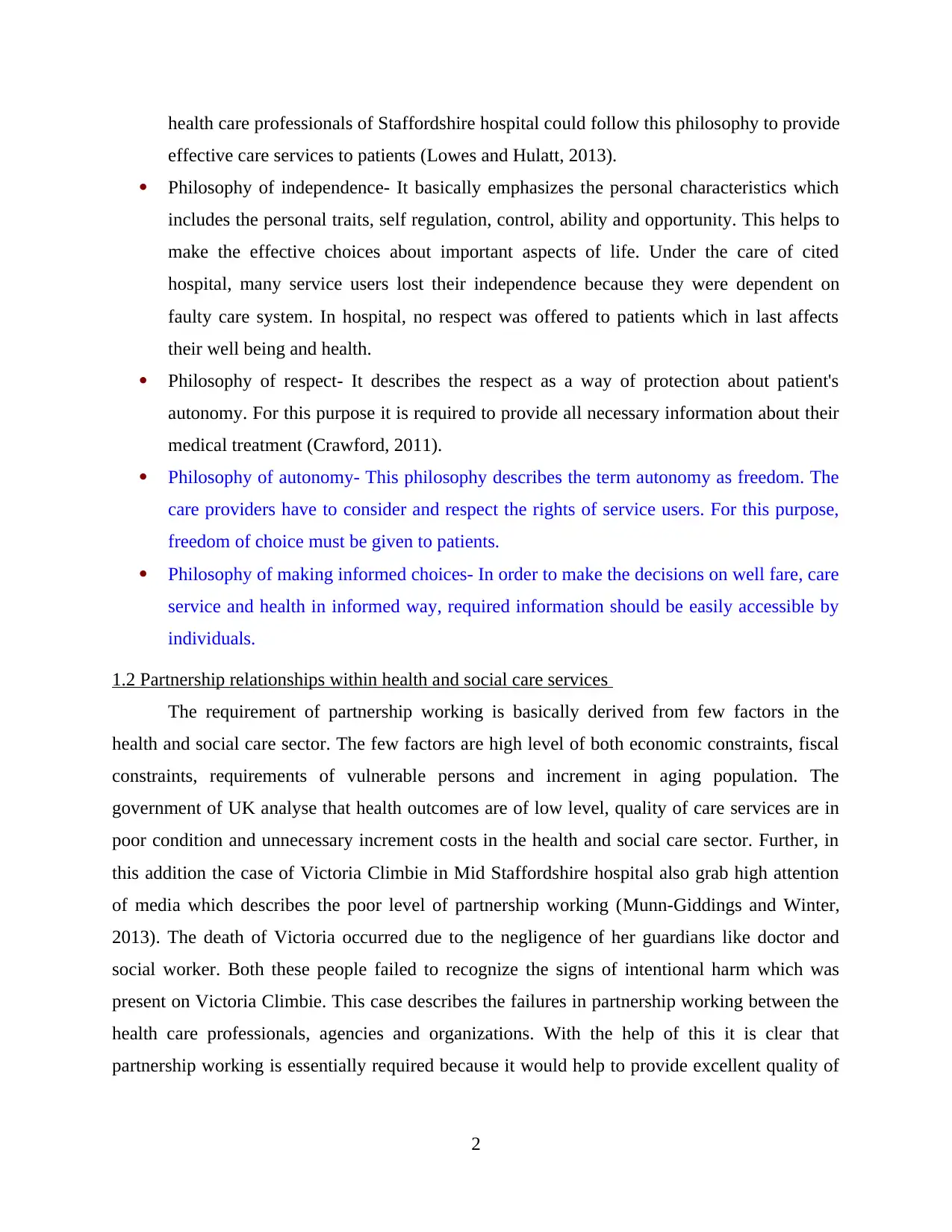
health care professionals of Staffordshire hospital could follow this philosophy to provide
effective care services to patients (Lowes and Hulatt, 2013).
Philosophy of independence- It basically emphasizes the personal characteristics which
includes the personal traits, self regulation, control, ability and opportunity. This helps to
make the effective choices about important aspects of life. Under the care of cited
hospital, many service users lost their independence because they were dependent on
faulty care system. In hospital, no respect was offered to patients which in last affects
their well being and health.
Philosophy of respect- It describes the respect as a way of protection about patient's
autonomy. For this purpose it is required to provide all necessary information about their
medical treatment (Crawford, 2011).
Philosophy of autonomy- This philosophy describes the term autonomy as freedom. The
care providers have to consider and respect the rights of service users. For this purpose,
freedom of choice must be given to patients.
Philosophy of making informed choices- In order to make the decisions on well fare, care
service and health in informed way, required information should be easily accessible by
individuals.
1.2 Partnership relationships within health and social care services
The requirement of partnership working is basically derived from few factors in the
health and social care sector. The few factors are high level of both economic constraints, fiscal
constraints, requirements of vulnerable persons and increment in aging population. The
government of UK analyse that health outcomes are of low level, quality of care services are in
poor condition and unnecessary increment costs in the health and social care sector. Further, in
this addition the case of Victoria Climbie in Mid Staffordshire hospital also grab high attention
of media which describes the poor level of partnership working (Munn-Giddings and Winter,
2013). The death of Victoria occurred due to the negligence of her guardians like doctor and
social worker. Both these people failed to recognize the signs of intentional harm which was
present on Victoria Climbie. This case describes the failures in partnership working between the
health care professionals, agencies and organizations. With the help of this it is clear that
partnership working is essentially required because it would help to provide excellent quality of
2
effective care services to patients (Lowes and Hulatt, 2013).
Philosophy of independence- It basically emphasizes the personal characteristics which
includes the personal traits, self regulation, control, ability and opportunity. This helps to
make the effective choices about important aspects of life. Under the care of cited
hospital, many service users lost their independence because they were dependent on
faulty care system. In hospital, no respect was offered to patients which in last affects
their well being and health.
Philosophy of respect- It describes the respect as a way of protection about patient's
autonomy. For this purpose it is required to provide all necessary information about their
medical treatment (Crawford, 2011).
Philosophy of autonomy- This philosophy describes the term autonomy as freedom. The
care providers have to consider and respect the rights of service users. For this purpose,
freedom of choice must be given to patients.
Philosophy of making informed choices- In order to make the decisions on well fare, care
service and health in informed way, required information should be easily accessible by
individuals.
1.2 Partnership relationships within health and social care services
The requirement of partnership working is basically derived from few factors in the
health and social care sector. The few factors are high level of both economic constraints, fiscal
constraints, requirements of vulnerable persons and increment in aging population. The
government of UK analyse that health outcomes are of low level, quality of care services are in
poor condition and unnecessary increment costs in the health and social care sector. Further, in
this addition the case of Victoria Climbie in Mid Staffordshire hospital also grab high attention
of media which describes the poor level of partnership working (Munn-Giddings and Winter,
2013). The death of Victoria occurred due to the negligence of her guardians like doctor and
social worker. Both these people failed to recognize the signs of intentional harm which was
present on Victoria Climbie. This case describes the failures in partnership working between the
health care professionals, agencies and organizations. With the help of this it is clear that
partnership working is essentially required because it would help to provide excellent quality of
2
Paraphrase This Document
Need a fresh take? Get an instant paraphrase of this document with our AI Paraphraser
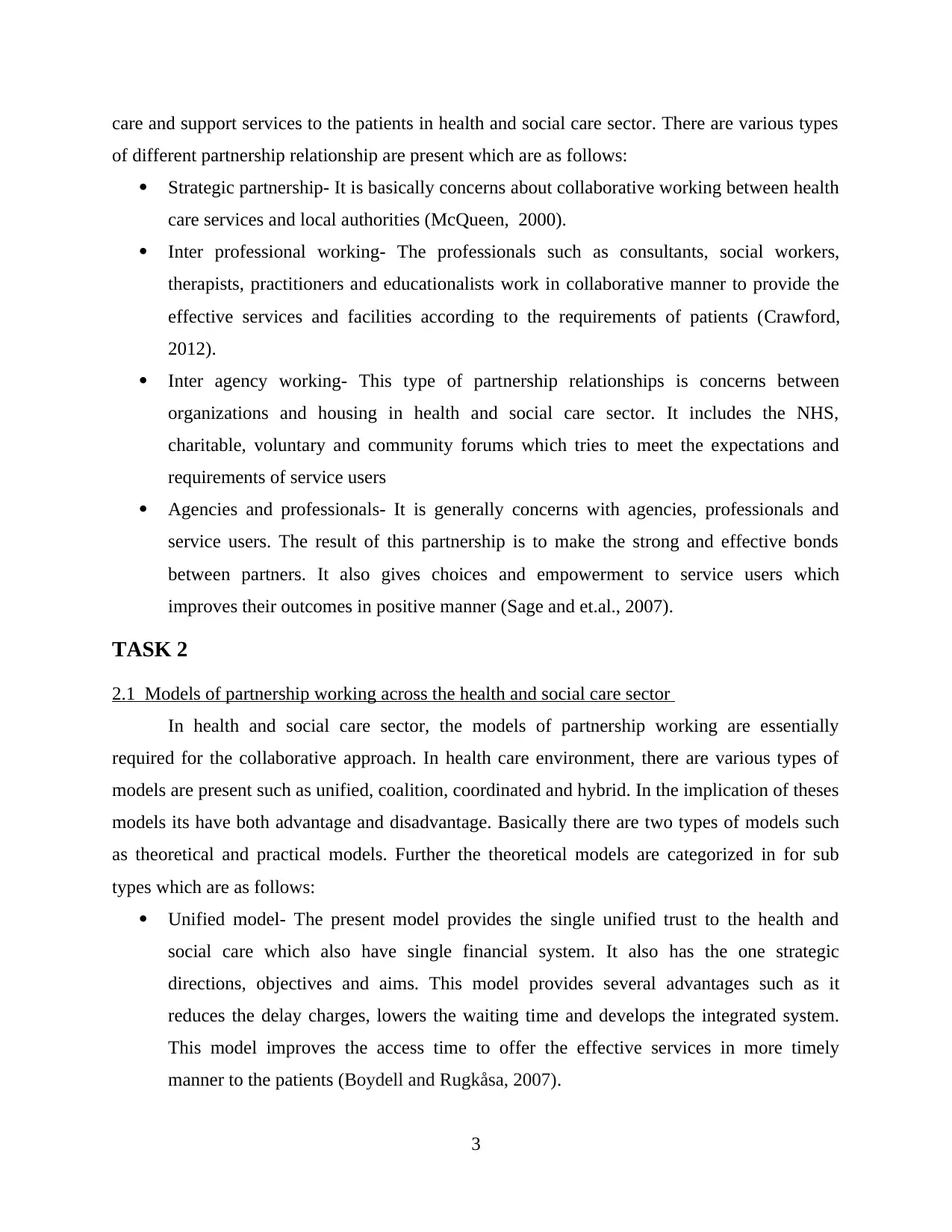
care and support services to the patients in health and social care sector. There are various types
of different partnership relationship are present which are as follows:
Strategic partnership- It is basically concerns about collaborative working between health
care services and local authorities (McQueen, 2000).
Inter professional working- The professionals such as consultants, social workers,
therapists, practitioners and educationalists work in collaborative manner to provide the
effective services and facilities according to the requirements of patients (Crawford,
2012).
Inter agency working- This type of partnership relationships is concerns between
organizations and housing in health and social care sector. It includes the NHS,
charitable, voluntary and community forums which tries to meet the expectations and
requirements of service users
Agencies and professionals- It is generally concerns with agencies, professionals and
service users. The result of this partnership is to make the strong and effective bonds
between partners. It also gives choices and empowerment to service users which
improves their outcomes in positive manner (Sage and et.al., 2007).
TASK 2
2.1 Models of partnership working across the health and social care sector
In health and social care sector, the models of partnership working are essentially
required for the collaborative approach. In health care environment, there are various types of
models are present such as unified, coalition, coordinated and hybrid. In the implication of theses
models its have both advantage and disadvantage. Basically there are two types of models such
as theoretical and practical models. Further the theoretical models are categorized in for sub
types which are as follows:
Unified model- The present model provides the single unified trust to the health and
social care which also have single financial system. It also has the one strategic
directions, objectives and aims. This model provides several advantages such as it
reduces the delay charges, lowers the waiting time and develops the integrated system.
This model improves the access time to offer the effective services in more timely
manner to the patients (Boydell and Rugkåsa, 2007).
3
of different partnership relationship are present which are as follows:
Strategic partnership- It is basically concerns about collaborative working between health
care services and local authorities (McQueen, 2000).
Inter professional working- The professionals such as consultants, social workers,
therapists, practitioners and educationalists work in collaborative manner to provide the
effective services and facilities according to the requirements of patients (Crawford,
2012).
Inter agency working- This type of partnership relationships is concerns between
organizations and housing in health and social care sector. It includes the NHS,
charitable, voluntary and community forums which tries to meet the expectations and
requirements of service users
Agencies and professionals- It is generally concerns with agencies, professionals and
service users. The result of this partnership is to make the strong and effective bonds
between partners. It also gives choices and empowerment to service users which
improves their outcomes in positive manner (Sage and et.al., 2007).
TASK 2
2.1 Models of partnership working across the health and social care sector
In health and social care sector, the models of partnership working are essentially
required for the collaborative approach. In health care environment, there are various types of
models are present such as unified, coalition, coordinated and hybrid. In the implication of theses
models its have both advantage and disadvantage. Basically there are two types of models such
as theoretical and practical models. Further the theoretical models are categorized in for sub
types which are as follows:
Unified model- The present model provides the single unified trust to the health and
social care which also have single financial system. It also has the one strategic
directions, objectives and aims. This model provides several advantages such as it
reduces the delay charges, lowers the waiting time and develops the integrated system.
This model improves the access time to offer the effective services in more timely
manner to the patients (Boydell and Rugkåsa, 2007).
3
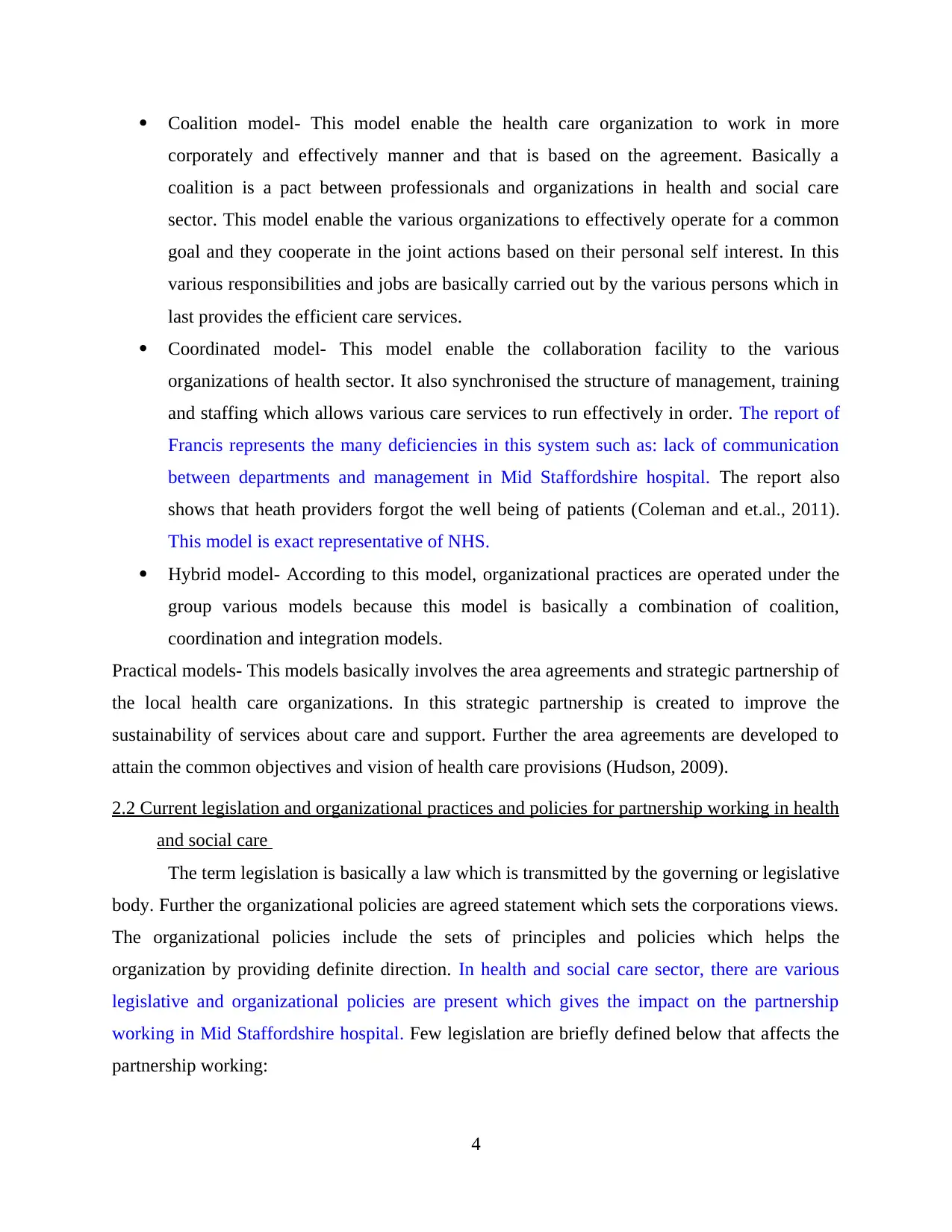
Coalition model- This model enable the health care organization to work in more
corporately and effectively manner and that is based on the agreement. Basically a
coalition is a pact between professionals and organizations in health and social care
sector. This model enable the various organizations to effectively operate for a common
goal and they cooperate in the joint actions based on their personal self interest. In this
various responsibilities and jobs are basically carried out by the various persons which in
last provides the efficient care services.
Coordinated model- This model enable the collaboration facility to the various
organizations of health sector. It also synchronised the structure of management, training
and staffing which allows various care services to run effectively in order. The report of
Francis represents the many deficiencies in this system such as: lack of communication
between departments and management in Mid Staffordshire hospital. The report also
shows that heath providers forgot the well being of patients (Coleman and et.al., 2011).
This model is exact representative of NHS.
Hybrid model- According to this model, organizational practices are operated under the
group various models because this model is basically a combination of coalition,
coordination and integration models.
Practical models- This models basically involves the area agreements and strategic partnership of
the local health care organizations. In this strategic partnership is created to improve the
sustainability of services about care and support. Further the area agreements are developed to
attain the common objectives and vision of health care provisions (Hudson, 2009).
2.2 Current legislation and organizational practices and policies for partnership working in health
and social care
The term legislation is basically a law which is transmitted by the governing or legislative
body. Further the organizational policies are agreed statement which sets the corporations views.
The organizational policies include the sets of principles and policies which helps the
organization by providing definite direction. In health and social care sector, there are various
legislative and organizational policies are present which gives the impact on the partnership
working in Mid Staffordshire hospital. Few legislation are briefly defined below that affects the
partnership working:
4
corporately and effectively manner and that is based on the agreement. Basically a
coalition is a pact between professionals and organizations in health and social care
sector. This model enable the various organizations to effectively operate for a common
goal and they cooperate in the joint actions based on their personal self interest. In this
various responsibilities and jobs are basically carried out by the various persons which in
last provides the efficient care services.
Coordinated model- This model enable the collaboration facility to the various
organizations of health sector. It also synchronised the structure of management, training
and staffing which allows various care services to run effectively in order. The report of
Francis represents the many deficiencies in this system such as: lack of communication
between departments and management in Mid Staffordshire hospital. The report also
shows that heath providers forgot the well being of patients (Coleman and et.al., 2011).
This model is exact representative of NHS.
Hybrid model- According to this model, organizational practices are operated under the
group various models because this model is basically a combination of coalition,
coordination and integration models.
Practical models- This models basically involves the area agreements and strategic partnership of
the local health care organizations. In this strategic partnership is created to improve the
sustainability of services about care and support. Further the area agreements are developed to
attain the common objectives and vision of health care provisions (Hudson, 2009).
2.2 Current legislation and organizational practices and policies for partnership working in health
and social care
The term legislation is basically a law which is transmitted by the governing or legislative
body. Further the organizational policies are agreed statement which sets the corporations views.
The organizational policies include the sets of principles and policies which helps the
organization by providing definite direction. In health and social care sector, there are various
legislative and organizational policies are present which gives the impact on the partnership
working in Mid Staffordshire hospital. Few legislation are briefly defined below that affects the
partnership working:
4
⊘ This is a preview!⊘
Do you want full access?
Subscribe today to unlock all pages.

Trusted by 1+ million students worldwide

The Health and Social Act 2012- This act helps to improve the quality of cares services
by offering the freedom for service providers. This act provides a new focus on to public
health and also empowers the patients (Health and Social Care Act 2012, 2010). It helps
to promote the effective service provisions and also improves the quality of services to
meet the requirements of patients in more efficient manner (Kirkpatrick and et.al., 2007).
Equality Act 2010- This act prevent the inequality and discrimination related to the race,
age, gender, religion and culture. The main aim of this act is to protect the all rights of
individual in right manner. In the public area and at work place, individuals are protected
from discrimination through this act. The entities of partnership are required to timely
review their procedures and policies (Equality Act 2010, 2010).
Data Protection Act 1998; 2003- To access the medical records, this data protection act
was amended in 2003 for the public concern. The main motive of this act is to protect the
personal information and data which could be present on papers, pictures, computer,
audio and database. It shows that all data should be highly protected and for this
password mechanism could be implemented for the electronic database. This act allows
the individual by offering the right to find out that what and where their information used
by the organization and government (Ansari, 2009).
As per the given case study of Mid Staffordshire hospital, it is evaluated that all these basic
procedures were highly ignored at workplace.
2.3 Differences in working practices and policies affect collaborative working
The differences in working practices and policies generally affects the collaborative
working in health and social care sector. The differences in policies and practices may occurs the
problems and confusion which could affect the operations and practices of partnership. In the
health care organization, the implementation of policies gives both positive and negative impact.
For the effective partnership working, few factors are essentially required such as respect,
communication, trust, understanding and dedication etc. Due to the presence of differences in
working practices following problems are raised in Mid Staffordshire hospital which are
discussed below:
Roles and responsibilities- If the importance of responsibilities and roles are not
understood effectively then it may develop the issues because workers of organizations
are not aware about the objectives and their contributing roles.
5
by offering the freedom for service providers. This act provides a new focus on to public
health and also empowers the patients (Health and Social Care Act 2012, 2010). It helps
to promote the effective service provisions and also improves the quality of services to
meet the requirements of patients in more efficient manner (Kirkpatrick and et.al., 2007).
Equality Act 2010- This act prevent the inequality and discrimination related to the race,
age, gender, religion and culture. The main aim of this act is to protect the all rights of
individual in right manner. In the public area and at work place, individuals are protected
from discrimination through this act. The entities of partnership are required to timely
review their procedures and policies (Equality Act 2010, 2010).
Data Protection Act 1998; 2003- To access the medical records, this data protection act
was amended in 2003 for the public concern. The main motive of this act is to protect the
personal information and data which could be present on papers, pictures, computer,
audio and database. It shows that all data should be highly protected and for this
password mechanism could be implemented for the electronic database. This act allows
the individual by offering the right to find out that what and where their information used
by the organization and government (Ansari, 2009).
As per the given case study of Mid Staffordshire hospital, it is evaluated that all these basic
procedures were highly ignored at workplace.
2.3 Differences in working practices and policies affect collaborative working
The differences in working practices and policies generally affects the collaborative
working in health and social care sector. The differences in policies and practices may occurs the
problems and confusion which could affect the operations and practices of partnership. In the
health care organization, the implementation of policies gives both positive and negative impact.
For the effective partnership working, few factors are essentially required such as respect,
communication, trust, understanding and dedication etc. Due to the presence of differences in
working practices following problems are raised in Mid Staffordshire hospital which are
discussed below:
Roles and responsibilities- If the importance of responsibilities and roles are not
understood effectively then it may develop the issues because workers of organizations
are not aware about the objectives and their contributing roles.
5
Paraphrase This Document
Need a fresh take? Get an instant paraphrase of this document with our AI Paraphraser

Difference on objectives- It is very important for the health care agencies to understand
the clear meaning and purpose of their existence and their objectives. If they are not
aware about their purpose then it may develop the issues to attain the organizational
objectives in effective way (Bernard, 2013).
Differenced in communication- The effective communication among all workers and
patients are essentially required because lack of communication provides the negative
impact. The lack of this factor creates communication gap between workers,
professionals and services users of Staffordshire hospital. Through this the quality of
their care and support services reduces and workers are not able to understand the
requirements of patients (Pinkus, 2005). The Francis report defines the lack of
communication at cited hospital.
Difference in culture- In partnership different types of workers works together for the
common objective. In this regard, workers are generally different from each other
because their place, religion and culture are different. Due to this, they have the different
beliefs, norms and values which sometimes also creates the barriers and issues that
affects the working practices.
TASK 3
3.1 Possible outcomes of partnership working for users of services, professionals and
organizations
The possible outcomes for these three areas are briefly defined as below:
Possible outcomes for the service users
The partnership working enhances the communication skills and levels among the health
care professionals, care workers and patients. It helps to make them feel safe at
Staffordshire hospital.
It provides the attention and care to the every individual patient which helps to improve
their health in fast manner.
The partnership working for patients helps them to deal with their diseases and traumas in
positive way (Braithwaite, Iedema and Jorm, 2007). It encourages individual to make the contact with patients which helps them to recover.
Outcomes for health care professionals
6
the clear meaning and purpose of their existence and their objectives. If they are not
aware about their purpose then it may develop the issues to attain the organizational
objectives in effective way (Bernard, 2013).
Differenced in communication- The effective communication among all workers and
patients are essentially required because lack of communication provides the negative
impact. The lack of this factor creates communication gap between workers,
professionals and services users of Staffordshire hospital. Through this the quality of
their care and support services reduces and workers are not able to understand the
requirements of patients (Pinkus, 2005). The Francis report defines the lack of
communication at cited hospital.
Difference in culture- In partnership different types of workers works together for the
common objective. In this regard, workers are generally different from each other
because their place, religion and culture are different. Due to this, they have the different
beliefs, norms and values which sometimes also creates the barriers and issues that
affects the working practices.
TASK 3
3.1 Possible outcomes of partnership working for users of services, professionals and
organizations
The possible outcomes for these three areas are briefly defined as below:
Possible outcomes for the service users
The partnership working enhances the communication skills and levels among the health
care professionals, care workers and patients. It helps to make them feel safe at
Staffordshire hospital.
It provides the attention and care to the every individual patient which helps to improve
their health in fast manner.
The partnership working for patients helps them to deal with their diseases and traumas in
positive way (Braithwaite, Iedema and Jorm, 2007). It encourages individual to make the contact with patients which helps them to recover.
Outcomes for health care professionals
6
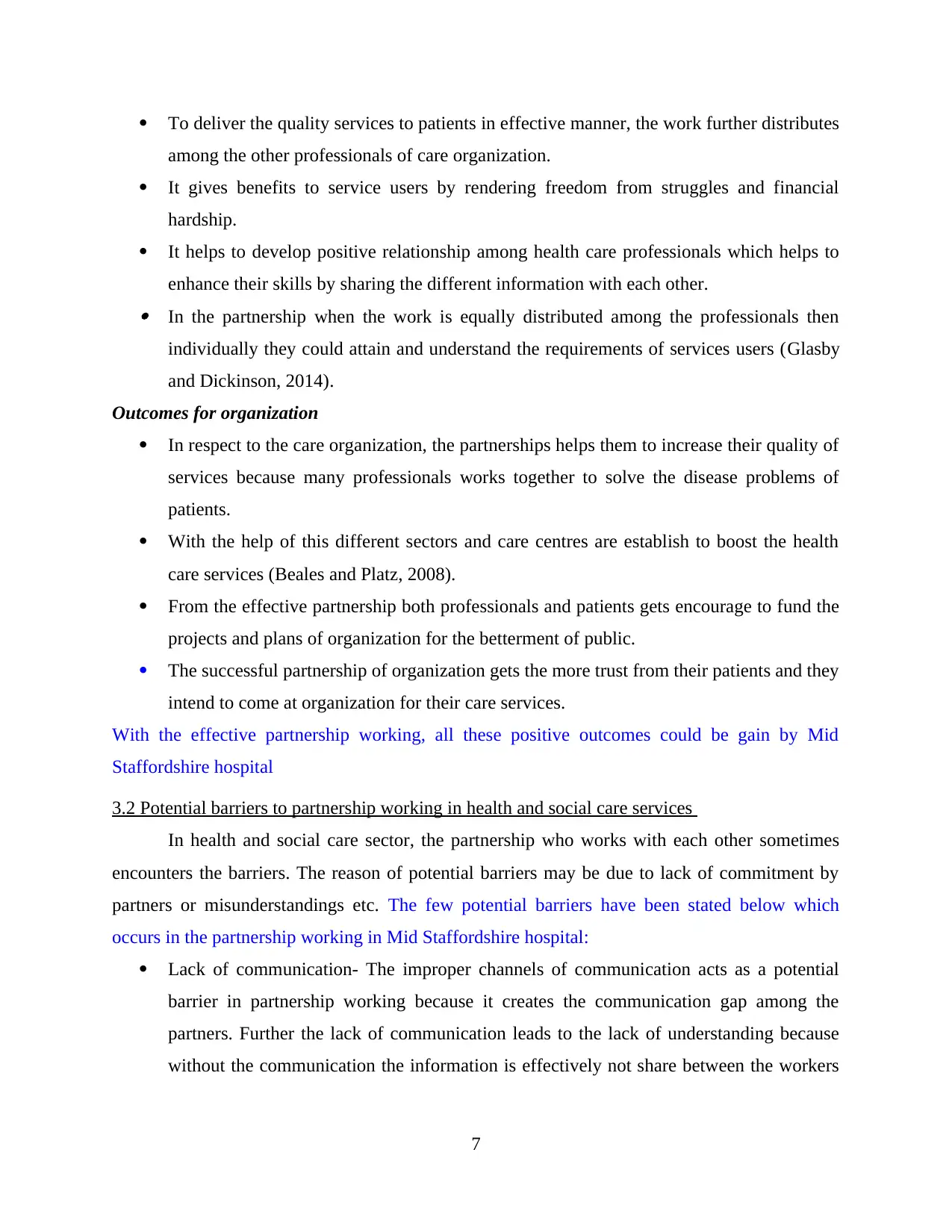
To deliver the quality services to patients in effective manner, the work further distributes
among the other professionals of care organization.
It gives benefits to service users by rendering freedom from struggles and financial
hardship.
It helps to develop positive relationship among health care professionals which helps to
enhance their skills by sharing the different information with each other. In the partnership when the work is equally distributed among the professionals then
individually they could attain and understand the requirements of services users (Glasby
and Dickinson, 2014).
Outcomes for organization
In respect to the care organization, the partnerships helps them to increase their quality of
services because many professionals works together to solve the disease problems of
patients.
With the help of this different sectors and care centres are establish to boost the health
care services (Beales and Platz, 2008).
From the effective partnership both professionals and patients gets encourage to fund the
projects and plans of organization for the betterment of public.
The successful partnership of organization gets the more trust from their patients and they
intend to come at organization for their care services.
With the effective partnership working, all these positive outcomes could be gain by Mid
Staffordshire hospital
3.2 Potential barriers to partnership working in health and social care services
In health and social care sector, the partnership who works with each other sometimes
encounters the barriers. The reason of potential barriers may be due to lack of commitment by
partners or misunderstandings etc. The few potential barriers have been stated below which
occurs in the partnership working in Mid Staffordshire hospital:
Lack of communication- The improper channels of communication acts as a potential
barrier in partnership working because it creates the communication gap among the
partners. Further the lack of communication leads to the lack of understanding because
without the communication the information is effectively not share between the workers
7
among the other professionals of care organization.
It gives benefits to service users by rendering freedom from struggles and financial
hardship.
It helps to develop positive relationship among health care professionals which helps to
enhance their skills by sharing the different information with each other. In the partnership when the work is equally distributed among the professionals then
individually they could attain and understand the requirements of services users (Glasby
and Dickinson, 2014).
Outcomes for organization
In respect to the care organization, the partnerships helps them to increase their quality of
services because many professionals works together to solve the disease problems of
patients.
With the help of this different sectors and care centres are establish to boost the health
care services (Beales and Platz, 2008).
From the effective partnership both professionals and patients gets encourage to fund the
projects and plans of organization for the betterment of public.
The successful partnership of organization gets the more trust from their patients and they
intend to come at organization for their care services.
With the effective partnership working, all these positive outcomes could be gain by Mid
Staffordshire hospital
3.2 Potential barriers to partnership working in health and social care services
In health and social care sector, the partnership who works with each other sometimes
encounters the barriers. The reason of potential barriers may be due to lack of commitment by
partners or misunderstandings etc. The few potential barriers have been stated below which
occurs in the partnership working in Mid Staffordshire hospital:
Lack of communication- The improper channels of communication acts as a potential
barrier in partnership working because it creates the communication gap among the
partners. Further the lack of communication leads to the lack of understanding because
without the communication the information is effectively not share between the workers
7
⊘ This is a preview!⊘
Do you want full access?
Subscribe today to unlock all pages.

Trusted by 1+ million students worldwide
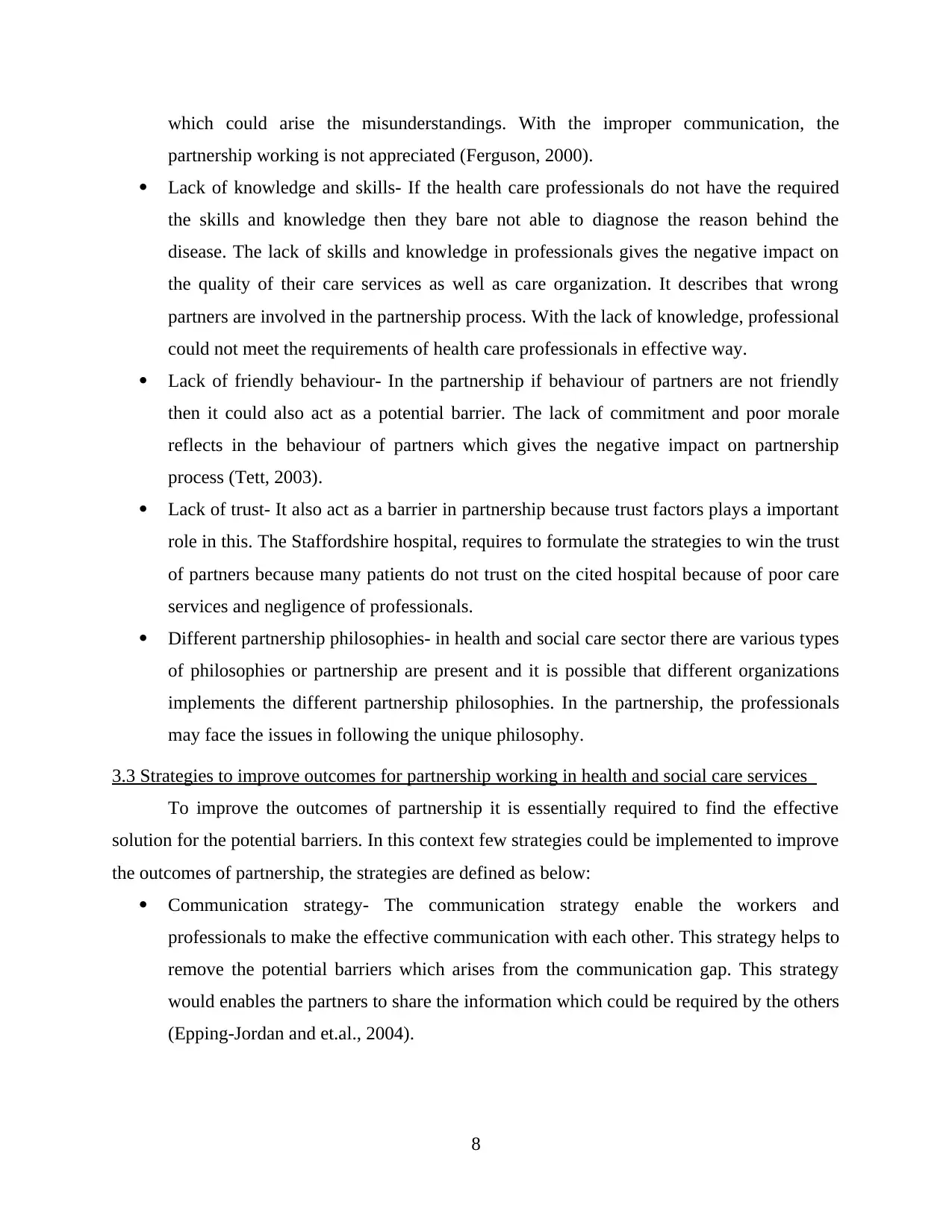
which could arise the misunderstandings. With the improper communication, the
partnership working is not appreciated (Ferguson, 2000).
Lack of knowledge and skills- If the health care professionals do not have the required
the skills and knowledge then they bare not able to diagnose the reason behind the
disease. The lack of skills and knowledge in professionals gives the negative impact on
the quality of their care services as well as care organization. It describes that wrong
partners are involved in the partnership process. With the lack of knowledge, professional
could not meet the requirements of health care professionals in effective way.
Lack of friendly behaviour- In the partnership if behaviour of partners are not friendly
then it could also act as a potential barrier. The lack of commitment and poor morale
reflects in the behaviour of partners which gives the negative impact on partnership
process (Tett, 2003).
Lack of trust- It also act as a barrier in partnership because trust factors plays a important
role in this. The Staffordshire hospital, requires to formulate the strategies to win the trust
of partners because many patients do not trust on the cited hospital because of poor care
services and negligence of professionals.
Different partnership philosophies- in health and social care sector there are various types
of philosophies or partnership are present and it is possible that different organizations
implements the different partnership philosophies. In the partnership, the professionals
may face the issues in following the unique philosophy.
3.3 Strategies to improve outcomes for partnership working in health and social care services
To improve the outcomes of partnership it is essentially required to find the effective
solution for the potential barriers. In this context few strategies could be implemented to improve
the outcomes of partnership, the strategies are defined as below:
Communication strategy- The communication strategy enable the workers and
professionals to make the effective communication with each other. This strategy helps to
remove the potential barriers which arises from the communication gap. This strategy
would enables the partners to share the information which could be required by the others
(Epping-Jordan and et.al., 2004).
8
partnership working is not appreciated (Ferguson, 2000).
Lack of knowledge and skills- If the health care professionals do not have the required
the skills and knowledge then they bare not able to diagnose the reason behind the
disease. The lack of skills and knowledge in professionals gives the negative impact on
the quality of their care services as well as care organization. It describes that wrong
partners are involved in the partnership process. With the lack of knowledge, professional
could not meet the requirements of health care professionals in effective way.
Lack of friendly behaviour- In the partnership if behaviour of partners are not friendly
then it could also act as a potential barrier. The lack of commitment and poor morale
reflects in the behaviour of partners which gives the negative impact on partnership
process (Tett, 2003).
Lack of trust- It also act as a barrier in partnership because trust factors plays a important
role in this. The Staffordshire hospital, requires to formulate the strategies to win the trust
of partners because many patients do not trust on the cited hospital because of poor care
services and negligence of professionals.
Different partnership philosophies- in health and social care sector there are various types
of philosophies or partnership are present and it is possible that different organizations
implements the different partnership philosophies. In the partnership, the professionals
may face the issues in following the unique philosophy.
3.3 Strategies to improve outcomes for partnership working in health and social care services
To improve the outcomes of partnership it is essentially required to find the effective
solution for the potential barriers. In this context few strategies could be implemented to improve
the outcomes of partnership, the strategies are defined as below:
Communication strategy- The communication strategy enable the workers and
professionals to make the effective communication with each other. This strategy helps to
remove the potential barriers which arises from the communication gap. This strategy
would enables the partners to share the information which could be required by the others
(Epping-Jordan and et.al., 2004).
8
Paraphrase This Document
Need a fresh take? Get an instant paraphrase of this document with our AI Paraphraser
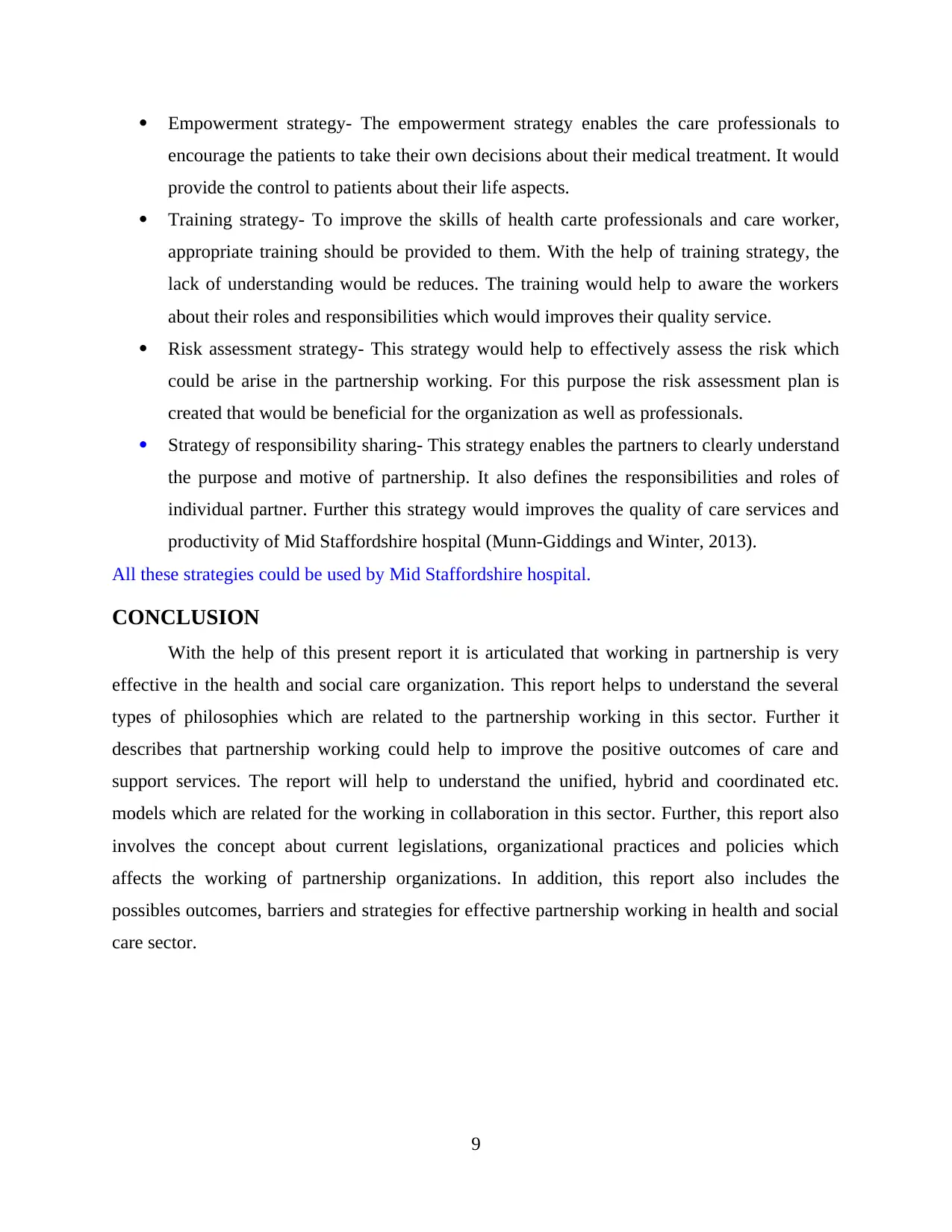
Empowerment strategy- The empowerment strategy enables the care professionals to
encourage the patients to take their own decisions about their medical treatment. It would
provide the control to patients about their life aspects.
Training strategy- To improve the skills of health carte professionals and care worker,
appropriate training should be provided to them. With the help of training strategy, the
lack of understanding would be reduces. The training would help to aware the workers
about their roles and responsibilities which would improves their quality service.
Risk assessment strategy- This strategy would help to effectively assess the risk which
could be arise in the partnership working. For this purpose the risk assessment plan is
created that would be beneficial for the organization as well as professionals.
Strategy of responsibility sharing- This strategy enables the partners to clearly understand
the purpose and motive of partnership. It also defines the responsibilities and roles of
individual partner. Further this strategy would improves the quality of care services and
productivity of Mid Staffordshire hospital (Munn-Giddings and Winter, 2013).
All these strategies could be used by Mid Staffordshire hospital.
CONCLUSION
With the help of this present report it is articulated that working in partnership is very
effective in the health and social care organization. This report helps to understand the several
types of philosophies which are related to the partnership working in this sector. Further it
describes that partnership working could help to improve the positive outcomes of care and
support services. The report will help to understand the unified, hybrid and coordinated etc.
models which are related for the working in collaboration in this sector. Further, this report also
involves the concept about current legislations, organizational practices and policies which
affects the working of partnership organizations. In addition, this report also includes the
possibles outcomes, barriers and strategies for effective partnership working in health and social
care sector.
9
encourage the patients to take their own decisions about their medical treatment. It would
provide the control to patients about their life aspects.
Training strategy- To improve the skills of health carte professionals and care worker,
appropriate training should be provided to them. With the help of training strategy, the
lack of understanding would be reduces. The training would help to aware the workers
about their roles and responsibilities which would improves their quality service.
Risk assessment strategy- This strategy would help to effectively assess the risk which
could be arise in the partnership working. For this purpose the risk assessment plan is
created that would be beneficial for the organization as well as professionals.
Strategy of responsibility sharing- This strategy enables the partners to clearly understand
the purpose and motive of partnership. It also defines the responsibilities and roles of
individual partner. Further this strategy would improves the quality of care services and
productivity of Mid Staffordshire hospital (Munn-Giddings and Winter, 2013).
All these strategies could be used by Mid Staffordshire hospital.
CONCLUSION
With the help of this present report it is articulated that working in partnership is very
effective in the health and social care organization. This report helps to understand the several
types of philosophies which are related to the partnership working in this sector. Further it
describes that partnership working could help to improve the positive outcomes of care and
support services. The report will help to understand the unified, hybrid and coordinated etc.
models which are related for the working in collaboration in this sector. Further, this report also
involves the concept about current legislations, organizational practices and policies which
affects the working of partnership organizations. In addition, this report also includes the
possibles outcomes, barriers and strategies for effective partnership working in health and social
care sector.
9
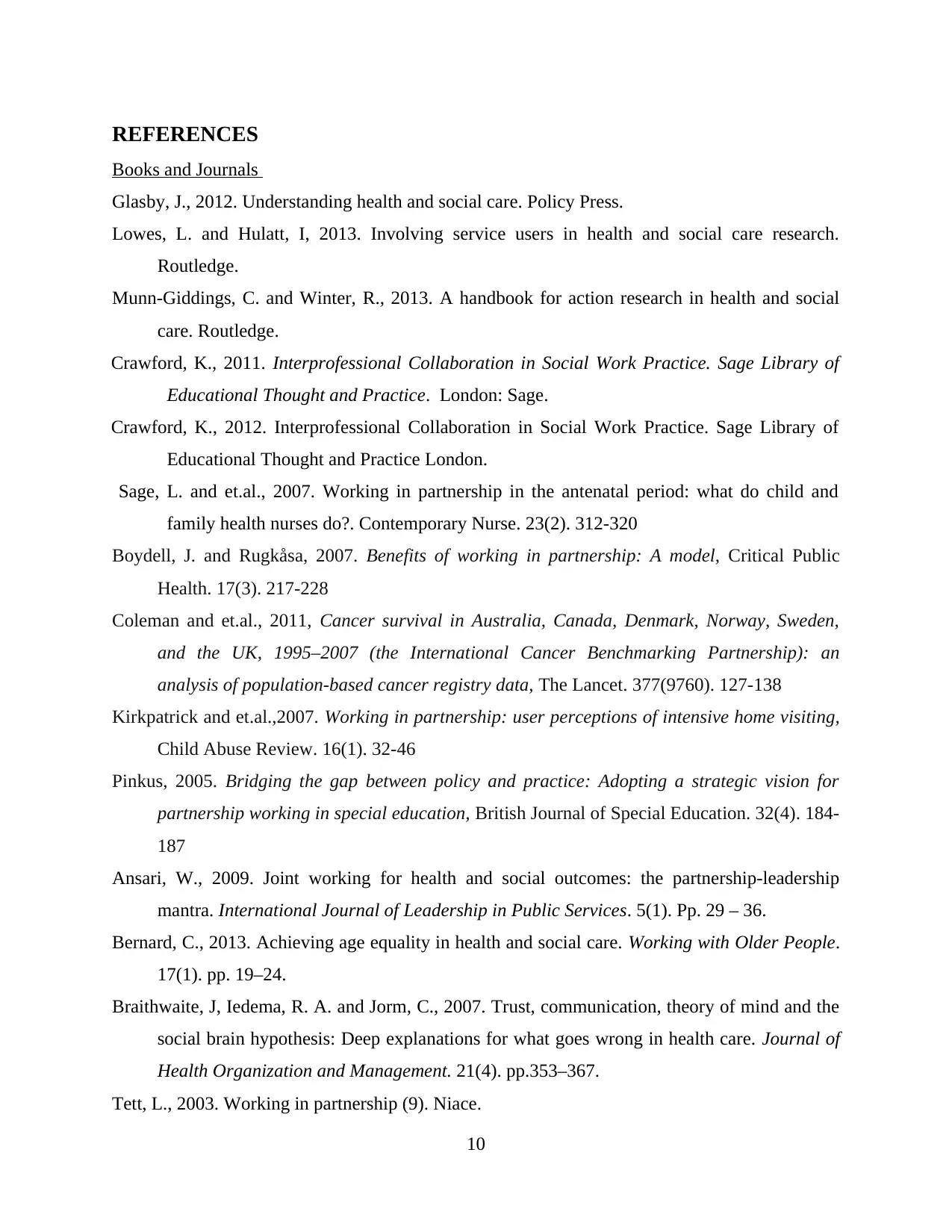
REFERENCES
Books and Journals
Glasby, J., 2012. Understanding health and social care. Policy Press.
Lowes, L. and Hulatt, I, 2013. Involving service users in health and social care research.
Routledge.
Munn-Giddings, C. and Winter, R., 2013. A handbook for action research in health and social
care. Routledge.
Crawford, K., 2011. Interprofessional Collaboration in Social Work Practice. Sage Library of
Educational Thought and Practice. London: Sage.
Crawford, K., 2012. Interprofessional Collaboration in Social Work Practice. Sage Library of
Educational Thought and Practice London.
Sage, L. and et.al., 2007. Working in partnership in the antenatal period: what do child and
family health nurses do?. Contemporary Nurse. 23(2). 312-320
Boydell, J. and Rugkåsa, 2007. Benefits of working in partnership: A model, Critical Public
Health. 17(3). 217-228
Coleman and et.al., 2011, Cancer survival in Australia, Canada, Denmark, Norway, Sweden,
and the UK, 1995–2007 (the International Cancer Benchmarking Partnership): an
analysis of population-based cancer registry data, The Lancet. 377(9760). 127-138
Kirkpatrick and et.al.,2007. Working in partnership: user perceptions of intensive home visiting,
Child Abuse Review. 16(1). 32-46
Pinkus, 2005. Bridging the gap between policy and practice: Adopting a strategic vision for
partnership working in special education, British Journal of Special Education. 32(4). 184-
187
Ansari, W., 2009. Joint working for health and social outcomes: the partnership‐leadership
mantra. International Journal of Leadership in Public Services. 5(1). Pp. 29 – 36.
Bernard, C., 2013. Achieving age equality in health and social care. Working with Older People.
17(1). pp. 19–24.
Braithwaite, J, Iedema, R. A. and Jorm, C., 2007. Trust, communication, theory of mind and the
social brain hypothesis: Deep explanations for what goes wrong in health care. Journal of
Health Organization and Management. 21(4). pp.353–367.
Tett, L., 2003. Working in partnership (9). Niace.
10
Books and Journals
Glasby, J., 2012. Understanding health and social care. Policy Press.
Lowes, L. and Hulatt, I, 2013. Involving service users in health and social care research.
Routledge.
Munn-Giddings, C. and Winter, R., 2013. A handbook for action research in health and social
care. Routledge.
Crawford, K., 2011. Interprofessional Collaboration in Social Work Practice. Sage Library of
Educational Thought and Practice. London: Sage.
Crawford, K., 2012. Interprofessional Collaboration in Social Work Practice. Sage Library of
Educational Thought and Practice London.
Sage, L. and et.al., 2007. Working in partnership in the antenatal period: what do child and
family health nurses do?. Contemporary Nurse. 23(2). 312-320
Boydell, J. and Rugkåsa, 2007. Benefits of working in partnership: A model, Critical Public
Health. 17(3). 217-228
Coleman and et.al., 2011, Cancer survival in Australia, Canada, Denmark, Norway, Sweden,
and the UK, 1995–2007 (the International Cancer Benchmarking Partnership): an
analysis of population-based cancer registry data, The Lancet. 377(9760). 127-138
Kirkpatrick and et.al.,2007. Working in partnership: user perceptions of intensive home visiting,
Child Abuse Review. 16(1). 32-46
Pinkus, 2005. Bridging the gap between policy and practice: Adopting a strategic vision for
partnership working in special education, British Journal of Special Education. 32(4). 184-
187
Ansari, W., 2009. Joint working for health and social outcomes: the partnership‐leadership
mantra. International Journal of Leadership in Public Services. 5(1). Pp. 29 – 36.
Bernard, C., 2013. Achieving age equality in health and social care. Working with Older People.
17(1). pp. 19–24.
Braithwaite, J, Iedema, R. A. and Jorm, C., 2007. Trust, communication, theory of mind and the
social brain hypothesis: Deep explanations for what goes wrong in health care. Journal of
Health Organization and Management. 21(4). pp.353–367.
Tett, L., 2003. Working in partnership (9). Niace.
10
⊘ This is a preview!⊘
Do you want full access?
Subscribe today to unlock all pages.

Trusted by 1+ million students worldwide
1 out of 13
Related Documents
Your All-in-One AI-Powered Toolkit for Academic Success.
+13062052269
info@desklib.com
Available 24*7 on WhatsApp / Email
![[object Object]](/_next/static/media/star-bottom.7253800d.svg)
Unlock your academic potential
Copyright © 2020–2025 A2Z Services. All Rights Reserved. Developed and managed by ZUCOL.





